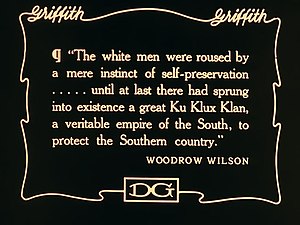Release Year: 1915
Director: D. W. Griffith
Cast: Lillian Gish, Mae Marsh, Henry B. Walthall, Miriam Cooper, George Siegmann.
Plot: The movie explains the story of two families (the Camerons in the South and the Stonemans in the North) and how they struggle during Civil War and posterior Reconstruction-Era. It also narrates the assassination of Abraham Lincoln and the creation of the Ku Klux Klan.
Review: D. W. Griffith has been mentioned and commented extensively in the theoretical part of this research project and with this movie he crowned himself as one of the best directors of his age.
Technically it is a huge achievement; using irising and blurring to introduce and close scenes or managing to make one hundred extras seem one thousand while representing a big battle.
But it also succeeded in the field of story telling; how it used all the techniques that had appeared during previous years all together in one movie to give it a meaning. A lot had happened between Méliès' and Porter's movies and film continuity was a reality. Instead of simple individual shots, we see a real connection between them. Apart from a wide range of techniques to give simbology to the movie, like insert shots. We can add to this cross-cutting, insert dialogues, the utilisation of different points of view (including close shots), flashbacks and the division of the movie in two well-structured parts. Each one of these details made of 'The Birth of a Nation' an elborate movie with a complex structure, where topics like war or romance through the distance are developed.

An example of introducing a scene with 'irising' technique
Huge and epic as it was, it became a huge box-office success, a blockbuster of its time, earning 10 millions on its release year and reaching the 50 two decades after, keeping the title of highest grossing film until 'Gone with the Wind'.
But even if the technical and narrative achievements must be acknowledged, I didn't like many aspects of the movie. To begin with, it's true that even with no spoken dialogues, the background music gives some sort of emotion to the movie, but over its three hours of length, it reaches a point where if you don't stop to have a break, continuing is unbearable. Moreover, the actors' performances are usually unreal and overacted, due to the inability to speak.
But the main reason why I disliked the movie is for its hugely racist interpretation of American history. Black people appear as aggressive and mean. and some events are distorted or inaccurate versions of the historical reality. Intending to glorify and justify its acts, a dramatized creation of the Ku Kux Klan is described as 'necessary' to restore the peace that the 'negros' had destroyed. As an example of its increasing xenophobia, the movie reuses actors whose characters die and paints them so they can play African American parts, sort of amusing if we consider that one of them interpretates Lincoln before his role change.


Clear examples of the racist message that the movie wanted to transmit
And that's just something I can't bear. Other achievements aside, the idea it tries to transmit is deplorable, and the fact that it became such a successful hit only demonstrates the ideology of society at that time.
.jpg)
.jpg)


No hay comentarios:
Publicar un comentario